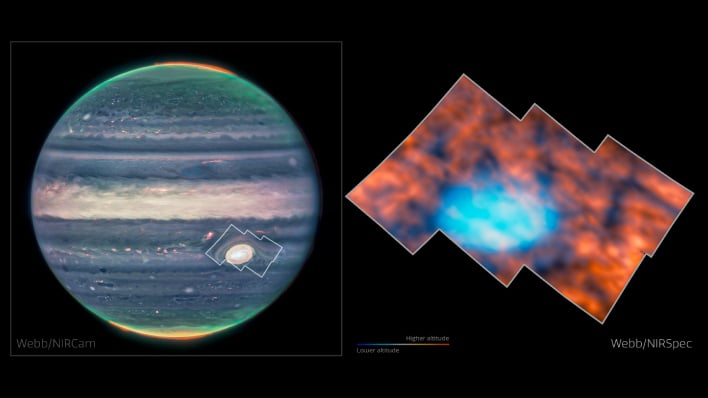
As Webb continues changing how astronomers and scientists view the Universe, its ability to capture objects in high-resolution has aided in unveiling new features in spots studied for decades. Such is the case with Jupiter’s Great Red Spot and a new feature that took astronomers by surprise.
In an image captured by Webb in July 2022, using the instrument’s Integral Field Unit capabilities, the observatory unveiled an infrared light emitted by hydrogen in Jupiter’s ionosphere above the giant gas planet’s Great Red Spot. The region, previously thought to be unremarkable, actually hosts a variety of intricate structures, including dark arcs and bright spots, across the entire field of view, according to the European Space Agency (ESA).
“We thought this region, perhaps naively, would be really boring,” remarked team leader Henrik Melin of the University of Leicester in the United Kingdom. “It is in fact just as interesting as the northern lights, if not more so. Jupiter never ceases to surprise.”
While the team investigating the new findings remarked the light emitted from the region is driven by sunlight, it adds there must be another mechanism which is altering the shape and structure of the upper atmosphere. Henrik explained one way the region might be altered is by gravity waves, similar to those of waves crashing on a beach. He added waves generated in the more turbulent lower atmosphere, around the Great Red Spot, then travel up in altitude, ultimately changing the structure and emissions of the upper atmosphere.
One theory that is being presented by a pair of astrophysicists with Princeton University and the SLAC National Accelerator Laboratory comprises potential evidence of the emitted light being caused by dark matter particles colliding. Researchers have suggested dark matter particles get pulled to Jupiter by its strong gravity and collide with its ionosphere. The same researchers reason there could be instances in which the collision produces light.
The new feature above Jupiter’s Great Red Spot will be studied again when ESA’s Jupiter Icy Moons Explorer, Juice, makes detailed observations of Jupiter and its three large ocean-bearing moons. Juice will use a suite of remote sensing, geophysical and in situ instruments to observe the planet and moons. Part of the probe’s mission is to explore Jupiter’s complex environment in depth, as well as study the wider Jupiter system as an archetype for gas giants throughout the Universe.
The observations from Webb were taken as part of the Early Release Science program. The results of the study can be viewed on Nature Astronomy.
